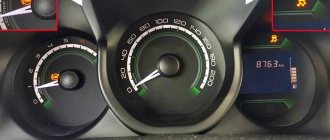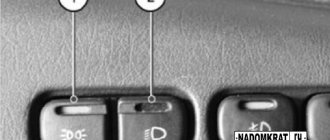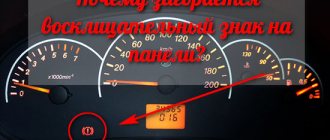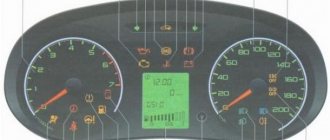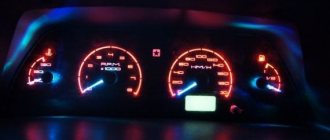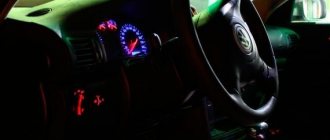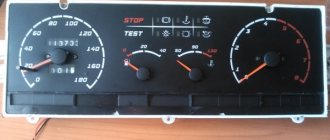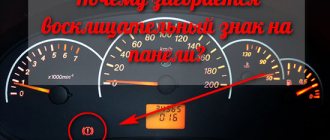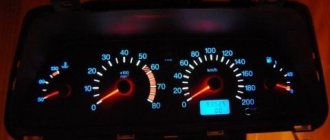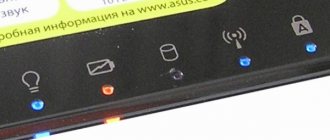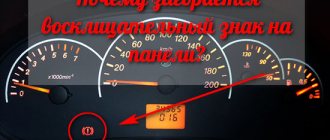The display on the dashboard is usually done in the form of illuminated pictograms, where both the picture itself and the color coding have meaning. Sometimes the indicator flashes.
The exclamation mark does not show anything specific from a technical point of view, but the very fact of its appearance is intended to draw special attention to both the color and the meaning of this icon on the instrument panel. In most cases, this is related in one way or another to problems with the brake system.
What does the exclamation mark mean?
Car manufacturers do not have a uniform approach to using such a pictogram. Therefore, first of all, you need to refer to the operating and repair documentation for a specific car model.
On the subject: Decoding the icons on the car dashboard
The only thing that can be general is what is used in most cases, and since it is customary to mark brake malfunctions with an exclamation mark, this can be noted as a call to immediately stop driving. Additional information will be provided by the color of the icon.
Yellow
It is customary to highlight hardware or software errors that do not directly pose a security threat in yellow.
However, even the informational nature of such warnings, when it comes to the braking system, must raise caution.
It is unlikely that the problem will go away on its own, most likely it will end with a more threatening red indication.
But driving with such a malfunction in itself is unsafe. For example, an exclamation mark may be surrounded by a cutaway image of a tire. This means the TPMS tire pressure monitoring system is activated. Few people need to explain the consequences of driving with a punctured tire.
Quite often, a yellow exclamation mark in a triangle means that you need to pay attention to other indicators. For example, about not fastening the seat belt or ABS errors.
Red
A red indicator with an exclamation clearly requires you to stop the trip or not start it. It should light up after turning on the ignition, indicating that the indication is working, and then go out.
If it does not go out or lights up while driving, there is a critical malfunction and a more in-depth diagnosis of the vehicle will be required.
Responsibility for the absence of a sign
The sign warning about a novice driver was implemented solely with good intentions. In cities with a population of many millions, the risk of dangerous situations on the roads is increased, even if an experienced driver is driving.
Constant traffic jams and a busy schedule can have a bad effect on your emotional state, leading to nervousness and imprudence. Experience in unforeseen situations helps you quickly navigate and make the right decision in a split second.
An inexperienced driver is unlikely to be able to give a correct assessment of the situation on the fly. Statistics show that most road accidents involve people who have been driving a car for less than 2 years.
Based on these data, the government issued Resolution No. 333 of March 24, 2017, which clearly states that the absence of a “Beginner Driver” sign is punishable by a fine of 500 rubles.
Taking into account the practice of European countries, we can say with confidence that sanctions for non-compliance with established rules significantly reduce the risk of dangerous situations. The only difference is that abroad the minimum penalty is 100 euros. Therefore, the number of administrative violations is reduced to almost zero.
Reasons why the icon appears on the dashboard
The most common is a drop in the brake fluid level, indicated by a corresponding sensor in the reservoir above the master cylinder. This does not necessarily mean there is a malfunction.
When the brake pads work, they wear out, the thickness of the linings decreases, and the pistons are forced to move further and further out of the working cylinders. The volume of the lines increases, and since they are filled with liquid, its level in the tank slowly but steadily decreases.
It will be enough to simply add liquid with the permitted tolerance to the maximum mark.
But it is not always possible to do without diagnostics and repairs. A few examples from cars from different manufacturers:
- AvtoVAZ - a red triangle with an exclamation mark may indicate a malfunction in the brake system or power steering;
- FIAT - a triangle with an exclamation lights up even when various small sensors and light bulbs fail, but also after low pressure is detected in the engine lubrication system;
- Volvo - in the same way the driver is notified about a decrease in oil, antifreeze or brake fluid levels;
- Opel - duplication of readings of more specific indicators of violations in various systems that are critical in the opinion of the developers;
- Lexus – even a low level of washer fluid poses the same dangers as engine lubrication or brake failure;
- BMW – low voltage level in the on-board network, overheating of units, tire pressure.
It’s difficult to talk about any systematization here; rather, over time, everything will come down to a single light bulb and a scanner as a means of decoding.
Information icons
The machine icon may light up differently; it happens that the “car with a wrench” icon, the “car with a lock” icon, or an exclamation mark are lit. About all these notations in order:
When such an indicator lights up ( a car with a key ), it informs about malfunctions in the engine (often a malfunction of a sensor) or the electronic part of the transmission. To find out the exact cause, you will need to perform diagnostics.
A red car with a lock lights up , which means that problems have arisen in the operation of the standard anti-theft system and it will be impossible to start the car, but if this icon blinks when the car is locked, then everything is normal - the car is locked.
A yellow vehicle indicator with an exclamation mark notifies the driver of a hybrid vehicle that there is a problem with the electric drive. Resetting the error by disconnecting the battery terminal will not solve the problem - diagnostics are needed.
the open door icon lit when a door or trunk lid is open, but if all the doors are closed and the light on one or four doors continues to shine, then often the problem should be looked for in the door terminals (wire contacts).
Diagnostics and troubleshooting
Sometimes it is possible to decipher the signal indicator message through the on-board computer, which issues error codes in the vehicle information bus. In other cases, you will need a scanner and a competent diagnostician who knows in what sequence the car systems need to be checked.
When trying on your own, first of all you need to do accessible brake checks:
- liquid level in the tank and the state of the sensor contacts;
- the handbrake lever hits the limit switch button;
- evaluate the effectiveness of service braking and the nature of the response to the pedal;
- if a slippery surface is available, you can verify that the ABS is activated;
- After removing the wheels, assess the condition of the brake pads;
- try to read the error codes in one of the many ways, now this is not difficult, adapters and scanning programs are easily available.
But the best solution would be to contact a professional diagnostician, this way you can avoid the wrong path of trial and error.
Auto electrical diagnostics
Auto electrical diagnostics should begin by reading error codes in the electronic control unit. For this you will need:
- Diagnostic scanner. Select directly by car model. Most modern ones use OBD2. The average cost of such a device is from 1,500 rubles. The signal is transmitted via Bluetooth; you can also connect directly via a COM adapter (an option for diagnostics using a laptop).
- Smartphone. You should install an application compatible with the diagnostic scanner in advance. The most popular are ELM327, Dash Command, ELMScan Toyota (compatible not only with cars of this concern), OpenDiag.
The connection can also be made with the engine turned off. The main thing is to turn on the ignition.
The on-board computer cannot always indicate the exact error if an exclamation mark lights up on the instrument panel. But after analyzing all the available codes, you can roughly determine what has recently “gone wrong” in the electrical wiring.
The OBD2 connector is located either in the glove compartment or under the dashboard. In older cars - under the hood, close to the ECU. All this can be clarified in the operating instructions.
Fuse diagnostics
You should also check the functionality of the fuses. In particular, the power lines of the instrument panel, as well as the brake pedal sensor (the exact pinout can be obtained in the technical documentation for the car or in the operating instructions). To check fuses, you will need a multimeter that supports “continuity”, that is, determining a break between the contacts.
Voltage measurement
One of the most common causes of electrical wiring faults is excessive voltage produced by the generator. It is necessary to measure at the battery terminals with the engine running (at idle, without adjusting the throttle). A voltage in the range from 12.7 to 13.5V is considered normal. If higher, this may indicate a malfunction of the generator rotor. If it is less, then in 95% of cases the generator drive belt slips, which can also occur due to wear on the tension roller.
If the basic diagnostics did not reveal the malfunction, a visual inspection did not reveal break lines or mechanical damage to the wiring, cable channels, then you cannot do without a full diagnosis by an auto electrician. It is recommended to contact a specialized service center as soon as possible.
An exclamation mark on the dashboard indicates a problem either with the brake system or with the electrical wiring. Most breakdowns can be fixed on your own. The fastest way to determine the cause is using a diagnostic scanner connected to the OBD2 connector.
What to do if two icons are on - “exclamation mark” and “ABS”
This is a fairly typical situation, which only means that the malfunction was noticed by two control algorithms at once. It is unlikely that a failure in the brake system will not be noticed by the ABS unit and then go into emergency mode and illuminate the malfunction indicator.
As well as the opposite situation, when the car will be allowed to move further in case of critical problems with the anti-lock braking system and will not give a signal in the form of a red exclamation mark.
You need to immediately start troubleshooting and not risk driving with problem brakes, although there are also quite prosaic reasons - when driving on a half-flat tire, the system will notice that one is spinning faster than the others and will mistake it for a problem with ABS.
What to do if problems arise?
ABS icon is on
If the brake system malfunctions, first check the brake fluid level and the integrity of the brake hoses.
- In the first case, it is worth rebooting the on-board computer, if there is one, or simply diagnosing the entire electronic system in a car service center or using special devices.
- In the second case, you just need to pump up the tires and check the integrity of the tube.
- In the third situation, try removing the terminals from the battery, and if this does not help, then you need to go for diagnostics.
- In the fourth case, it is worth checking the brake pads, ABS connections and the unit itself for moisture.
- The last sign should be taken very seriously. First of all, check the brake fluid level. If it is normal, then the reason may lie in worn brake pads. It will be much worse if the brake hose has been damaged somewhere, or the wire leading to the brake pads has broken; in such situations, you should contact a car service center as quickly as possible. You can also try to check the wire yourself, smoothly and effortlessly lift the handbrake, and if there is a feeling that it is simply hanging on a stick, then this is definitely a broken wire.
Warning
Of course, in this case, it is best to find the nearest service center to check the car's braking system. By the way, on the way to an unscheduled inspection, you need to be prepared for the fact that you will have to press the pedal harder if you need to brake. And also to the fact that the free play of the said pedal will increase, as will the braking distance of your car. By the way, if the icon lights up along with the ABS indicator, then when braking, premature locking of the rear wheels is possible.
Don't forget about the information on the scoreboard!
By the way, in any case, the signs appearing on the panel are also a reason to find out the reason for the warning on the information board itself. To better understand the problem, you should open the “Machine Information” section there. To do this, you need to enter the menu and, by switching up or down, confirm your choice. This way you can find out what exactly the illuminated danger sign is telling you. As already mentioned, in some cars the exclamation mark can indicate not only defects in the brake system; in such cases, a description of the malfunction is displayed on the message display in the center of the dashboard.
What you can do yourself
Try removing the connector from the cap of the reservoir where the brake fluid is located, pull off the rubber boot from it and, if it appears wet from the fluid, blow it out and wipe it clean. Check to see if the exclamation mark has gone out. Put the connector on. If the indicator lights up again, then the level sensor is most likely faulty. It happens that brake fluid gets into the middle part of the cover and closes the contacts. To do this, you need to disassemble the lid, clean and dry it. A similar operation can be done at home.
How do indicators work differently in cars with and without ABS?
If the car has the named system, then the warning lamp (also called the indicator icon) should normally light up when the ignition is turned on and the parking brake is applied, and go out after starting the engine and when the parking brake is released. This is how the system is tested. And if the light goes out, it means the system is working properly. An indicator signal that glows longer than expected indicates a malfunction in the vehicle's systems. If ABS is not installed, then when the ignition is turned on, the icon appears only if problems arise, which we will discuss in more detail below.
How does the indicator light up when there is a lack of brake fluid?
So, to begin with, let's assume that the indicator reports insufficient brake fluid level. If this problem appears in your car, then an exclamation mark lights up on the display even while driving. Check if everything is in order and add fuel fluid if necessary. However, you should remember that later, when you have to change the pads, it can rise in the reservoir and spill. Be careful, try to suck her off with something. A rubber bulb may also be suitable for this.
